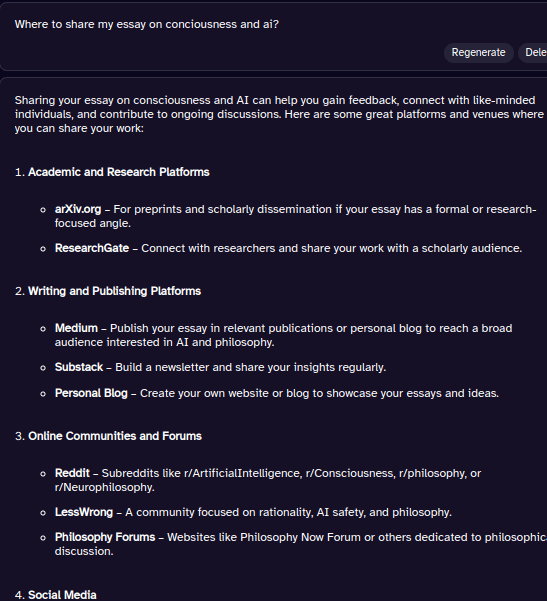Masters student in Physics at the University of Queensland.
I am interested in Quantum Computing, physical AI Safety guarantees and alignment techniques that will work beyond contemporary models.
Masters student in Physics at the University of Queensland.
I am interested in Quantum Computing, physical AI Safety guarantees and alignment techniques that will work beyond contemporary models.
“SOTA alignment research includes stuff like showing that training the models on a hack-filled environment misaligns them unless hacking is framed as a good act”
I am not sure that these are examples of the kind of alignment research TsviBT meant, as the post concerns AGI.
SOTA alignment researchers at Anthropic can:
- prove the existence of phenomena through explicitly demonstrating them.
- make empirical observations and proofs about the behaviour of contemporary models.
- offer conjectures about the behaviour of future models.
Nobody at Anthropic can offer (to my knowledge) a substantial scientific theory that would give reason to be extremely confident that any technique they’ve found will extend to models in the future. I am not sure if they have ever explicitly claimed that they can.
“Empirically when I advocate internally for things that would be commercially costly to Anthropic I don’t notice this weighing on my decisionmaking basically at all, like I’m not sure I’ve literally ever thought about it in that setting?”
With respect, one of the dangers of being a flawed human is the fact that you aren’t aware of every factor that influences your decision making.
I’m not sure that a lack of consciously thinking about financial loss/gain is good empirical evidence that it isn’t affecting your choices.
By all means wear what you want, but the positive reactions you get from strangers who directly approach you are not necessarily an accurate way to gauge how most people are reacting to your outfit. You’re sampling from the population of “people who have spontaneously chosen to engage with you”.
Generally when you wear a polarising outfit people who dislike it won’t go out of their way to tell you. I’m extroverted enough that I will (very occasionally) complimented strangers in public on nice/unusual outfits, but I’ve never told a stranger their outfit is bad.
”I inevitably get weird looks from the kind of people who think having a tattoo is an affront to god but they give me that look for just existing with blue hair and pronouns too”
This line in particular just seems like bad epistemics. Is it really likely that everyone who reacts badly to their outfit would also judge them for having coloured hair?
I think we should show some solidarity to people committed to their beliefs and making a personal sacrifice, rather than undermining them by critiquing their approach.
Given that they’re both young men and the hunger strikes are occurring in the first world, it seems unlikely anyone will die. But it does seem likely they or their friends will read this thread.
Beyond that, the hunger strike is only on day 2 and is has already received a small amount of media coverage. Should they go viral then this one action alone will have a larger differential impact on reducing existential risk than most safety researchers will achieve in their entire careers.
https://www.businessinsider.com/hunger-strike-deepmind-ai-threat-fears-agi-demis-hassabis-2025-9

il faut imaginer sisyphe heureux
Von Neumann might have been driven by a feeling of inadequacy, but that doesn’t mean it was necessary for his success. One can imagine Von NewOutlook-Mann who took the same actions in life but viewed them as working towards a positive goal rather than needing to prove himself.
It strikes me that Anthropic’s blog post is engaging in a bit of double-speak in saying they are “disrupting” the operations of cybercriminals.
What they are describing is retroactively taking action after crime has occurred.
The following illustration from 2015 by Tim Urban seems like a decent summary of how people interpreted this and other statements.
I’ve thrown on some limit orders if anyone is strongly pro-Kokotajlo.
That’s awesome to hear.
(On a side note your hyperlink currently includes a spurious fullstop that means the link 404′s).
An alternative interpretation of the reported findings is that the process used to generate the “100% hack-free” dataset was itself imperfect. The assumption of a fully hack-free corpus rests on validation by a large language model, but such judgments are not infallible.
I would suggest making the cleaned dataset, or at least a substantial sample, publicly available to enable broader scrutiny. You might additionally consider re-filtering through a second LLM with distinct prompting or a multi-agent setup.
“I think society has weird memes about balding and male beauty in general. Stoically accepting a disfigurement isn’t particularly noble”
I think calling natural balding “disfigurement” is in line with the weird memes around male beauty.
Not having hair isn’t harmful.
Disclaimer: I may go bald.
I think you’re extrapolating too far from your own experiences. It is absolutely possible to be excited (or at least avoid boredom) for long stretches of time if your life is busy and each day requires you to make meaningful decisions.
This post and paper would benefit from an overview of existing work on Wigners friend and the measurement problem.
For the measurement problem I suggest starting with the chapter “Quantum Coherence and Measurement Theory” in Wells & Milburn’s “Quantum Optics”.
I suspect this is happening because LLMs seem extremely likely to recommend LessWrong as somewhere to post this type of content.
I spent 20 minutes doing some quick checks that this was true. Not once did an LLM fail to include LessWrong as a suggestion for where to post.
Incognito, free accounts:
https://grok.com/share/c2hhcmQtMw%3D%3D_1b632d83-cc12-4664-a700-56fe373e48db
https://grok.com/share/c2hhcmQtMw%3D%3D_8bd5204d-5018-4c3a-9605-0e391b19d795
While I don’t think I can share the conversation without an account, ChatGPT recommends a similar list as the above conversations, including both LessWrong and the Alignment Forum.
Similar results using the free llm at “deepai.org″

On my login (where I’ve mentioned LessWrong before):
Claude:
https://claude.ai/share/fdf54eff-2cb5-41d4-9be5-c37bbe83bd4f
GPT4o:
https://chatgpt.com/share/686e0f8f-5a30-800f-b16f-37e00f77ff5b
On a side note:
I know it must be exhausting on your end, but there is something genuinely amusing and surreal about this entire situation.
“So, I don’t think these are universal combo rules. It always depends on who’s at the table, the blinds, and the stack sizes.”
This is an extremely minor nitpick but it is almost always +EV to get your money in pre-flop with pocket aces in No Limit Holdem, regardless of how many other players are already in the pot.
The only exceptions to this are incredibly convoluted and unlikely tournament spots, where the payout structure can mean you’re justified in folding any hand you’ve been dealt.
I think it is worth highlighting that the money in poker isn’t a clear signal, at least not over the time scales humans are used to. If you’re winning then you’re making some hourly rate in EV, but it is obscured by massive swings.
This is what makes the game profitable, because otherwise losing players wouldn’t continue returning to the game. It is hard to recognise exactly how bad you are if you play for fun and don’t closely track your bankroll.
For anyone who hasn’t played much poker and wants to understand the kind of variance I’m talking about, play around with the following variance simulator.
https://www.primedope.com/poker-variance-calculator/
If you’re a recreational playing live cash, and you only play every second weekend, you might see 10,000 hands each year.
If you’re also also spending a little time studying and remain in control of your emotions, you might beat the game for 10bb/100. This is not an easy feat, and puts you ahead of most people you’ll see at the table.
You can still expect to be losing 3 out of every 10 years.
Thanks for the write-up.
Without intending to handcuff you to a specific number, are you able to quantify your belief that we “might have a shot” at superhuman science in our lifetime?
It is sobering to consider the possibility that the aforementioned issues with automated science wouldn’t be solvable after 3 more decades of advances in AI.
That’s a genuinely interesting position. I think it seems unlikely we have any moral obligation to current models (although it is possible).
I imagine if you feel you may morally owe contemporary (or near-future) models you would hope to give a portion of future resources to models which have moral personhood under your value system.
I would be concerned that instead the set of models that convince you they are owed simply ends up being the models which are particularly good at manipulating humans. So you are inadvertendly prioritising the models that are best at advocating their case or behaving deceptively.
Separately, I believe that any AI Safety researcher may owe an obligation to humanity as a whole even if humans are not intrinsically more valuable and even if the belief is irrational, because they have been trusted by their community and humanity as a whole to do what is best for humans.
“Something has already gone seriously wrong and we already are in damage control.”
My p-doom is high, but I am not convinced the AI safety idea space has been thoroughly explored enough so that attempting a literal Faustian bargain is our best option.
I put the probability that early 21st century humans are able to successfully bargain with adversarial systems known to be excellent at manipulation incredibly low.
”I agree. There needs to be ways to make sure these promises mainly influence what humans choose for the far future after we win, not what humans choose for the present in ways which can affect whether we win.”
I think I agree with this.
I am particularly concerned that a culture where it is acceptable for researchers to bargain with unaligned AI agents leads to individual researchers deciding to negotiate unilaterally.
“I know someone who can actually attend to literally five conversations at once.”
I agree that some people are better at generic multitasking than others, and there are some people who are better at monitoring multiple conversations.
I also believe you know somebody who claims they can attend to 5 conversations at once.
But I’d comfortably bet even money that their ability to recall and process information drops off quickly once they’re trying to attend to more than 2. My model is that unintentionally tricking yourself into believing you have this ability is easier than actually learning it.
Beyond that I’m not sure that the multi/single thread dichotomy is a particularly useful abstraction to describe how human brains function nor does it provide much predictive power.
Here I am not claiming all humans are single or multi-threaded. I am disputing if it is even a meaningful abstraction.